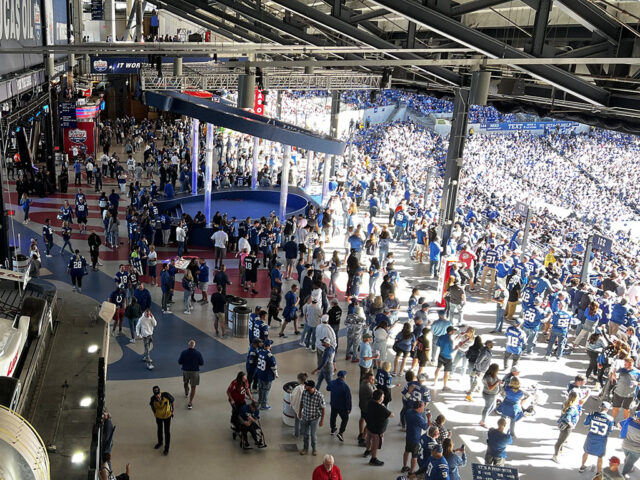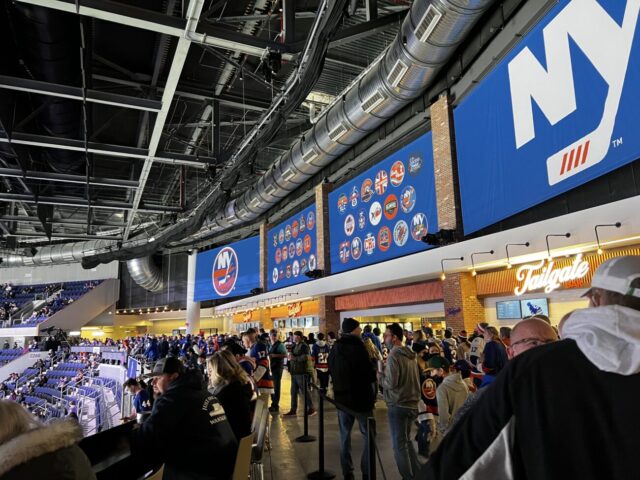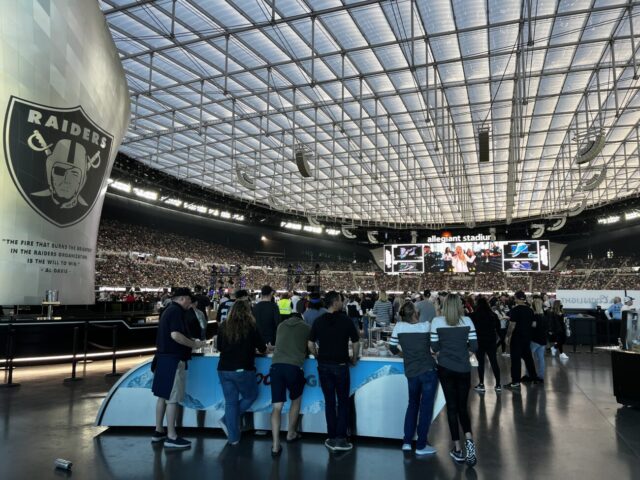The more games I go to, the more I realize I like to spend a lot of my time in standing-room sections at the stadium.
I’m clearly not alone in this thought. Whenever I do seek out good standing-room spots, they’re always packed.
And it’s not always because the people in those sections didn’t buy ticket for seats — standing-room only tickets are sold less frequently these days, as teams have become more savvy about the value propositions they provide fans with the price of admission (more on that below).
Nope, it’s simply become more frequent that fans prefer to stand than sit. Ever watch a game on TV, see a panning shot of the stands with large pockets of empty seats, and think to yourself, “Hm, guess [insert team here] isn’t drawing well these days”?
Well, you might have to consider that those fans have decided they can get more enjoyment out of their game experience by spending time somewhere else besides their seat.
The teams have certainly noticed this trend. Several new venues have been designed with open spaces for standing and mingling — often these spots are added in places that, in the past, would have been recognized as prime seating sections.
Older venues have come to realize the importance of these spaces. Venerable ballparks such as Wrigley Field and Dodger Stadium made the addition of bar-equipped party plazas a central part of their respective renovations.
Meanwhile, Crypto.com Arena is in the midst of a revamp that will remove several sections of upper-deck seating in favor of a larger standing-room party area. They’re not the first sports venue to sacrifice fixed seats for fluid standing spots, and they certainly won’t be the last.
Perhaps you’ve read all of this and thought to yourself: Why? Why would a fan prefer to stand in a crowded space with an often obstructed view of the game rather than sit in the seat he or she likely paid top-dollar for?
I know people have these questions because I had them myself for a long time. I felt that to get the most utility out of your game ticket, you had to watch as much game action as possible, only missing time to get food or go to the bathroom.
Over the years I’ve discovered — as have teams, clearly — that attending a sporting event is supposed to be an experience. That means different things to different people, of course, but for fewer and fewer people, sitting down for up to three hours isn’t an optimal experience.
Still not convinced? Here’s what I’ve learned from spending time in standing-room sections and party plazas.
It’s all about the community
For many fans, the next-best thing to watching a game live at a stadium is to watch it in a sports bar, among a crowd of like-minded patrons. So if those are your two most preferred environments, why not combine them?
In essence, standing-room party plazas at stadiums are about capturing the sports-bar experience. There’s always a bar, or at least a food and drink stand (but seriously, it’s always a bar) nearby for easy access.
In fact, the best and most popular stadium standing-room party plazas look like sports bars, only with an actual game taking place in front of you. Yes, there are usually TVs showing the game (and sometimes out-of-town games depending on the sport). There are often bar tables and stools for people to sit and talk.
If you’re attending a game with a large group — say, six or more — then this atmosphere promotes the social aspect of the outing far more than sitting in a single row does. Many groups will opt for the club or suite experience, but for those attending on a budget, standing-room plazas fit the bill for far cheaper.
More food and drink within your reach
As mentioned above, standing-room plazas at stadiums always come fitted with bars and food/drink stands.
There’s a reason for that, of course. Psychologically, one of the biggest nuisances for a live sports fan is the need to get up out of his or her seat to buy food or beer. It often requires missing a significant portion of the action and standing in long lines.
Aisle-roaming vendors sometimes solve this problem, but let’s face it: Most fans would agree that they don’t come around often enough (and logistically, it’s not really possible to have them come by as frequently as many would like).
To be honest, the party plaza doesn’t really address the issue, either. The bars and food stands are usually set far enough back that no one standing in line can see the game.
The difference is that fans don’t have to leave that established communal atmosphere for the errand. Instead, they can remain engaged in the ambiance, still able to participate in the crowd reaction for a key moment in the game.
Anyone who’s ever experienced FOMO by being caught in the bowels of an arena while they hear muffled roars from the seating bowl can appreciate why this distinction is so important.
Freedom of movement
I consider myself a pretty restless sort. Thus, it’s become harder and harder for me over the years to sit in a seat for the sustained stretches of time it takes to watch a sporting event.
Over my years of attending games, I’ve observed more and more people who clearly feel the same way. Whether it’s about stretching their legs (or wearing a device that’s telling them not to be so stationary all the time), wanting to explore stadiums that increasingly have more Easter eggs for the curious fan, or simply looking for a different vantage point (more on that below), the motivation to get up and roam is clearly there.
Perhaps that urge has always been there for many fans — it’s just that stadiums and arenas are more frequently addressing it in their design.
Two fairly new arenas I’ve visited in the last couple years have skillfully incorporated this into their layouts. Both Chase Center in San Francisco and UBS Arena, just outside New York City, designed their upper-deck seating as a horseshoe, leaving room for a standing-room party plaza that overlooks the event floor.
If a stadium or arena you’ve visited doesn’t have ample room for you to view the game from a concourse area, chances are the next renovation will address that post-haste. Paycor Stadium in Cincinnati is one such venue considering more standing-room space as the trend is only getting more popular.
Unique points of view
So you’ve shelled out some hard-earned money for a ticket, only to find your view of the game is inferior to what you are accustomed to seeing on TV. What to do?
One advantage of standing-room areas at stadiums is that it offers fans different vantage points for the game.
No, they’re not typically better than the views you get at seats — teams aren’t THAT all-in on standing-room areas. But they do offer a fresh perspective on the game and provide a different value to reward your time and money spent.
If it’s your first visit to a stadium — or if you’ve traveled for the game and it potentially is your only visit — you might find it rewarding to seek out different vantage points. And at more and more venues, you can do so easily without missing too much game action.
* * *
Are you inspired to roam about and stand at your next sporting event? Or still believe staying in your seat is the way to go? We’d love to hear your opinion! Let us know in the comments below or drop us a line via email.




 Edward de la Fuente | Itinerant Fan
Edward de la Fuente | Itinerant Fan
